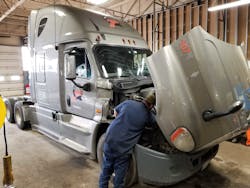Looking ahead: Contingency planning for a possible COVID-19 aftermath
Class 8 orders in March slumped to their lowest monthly total in 10 years, a telltale sign that fleets aren’t investing in a lot of new equipment right now due to the COVID-19 pandemic. According to Tom Moore, executive vice president for the National Private Truck Council (NPTC), there will likely be continued disruption up and down and throughout the supply chain for several months to come.
Many NPTC members, at least for the short term, are leasing equipment and drivers, Moore pointed out during an April 14 FleetOwner webinar, “Navigating Your Fleet Through the Pandemic.” Amanda Schuier, senior vice president of Quality Transport Company, and David Heller, vice president of government affairs for the Truckload Carriers Association (TCA), joined Moore for the webinar.
“Those companies that have capacity and drivers because their business is down are leasing them to companies that have more volume than they can handle with their existing fleets,” he explained. “That’s helpful to both sides of the equation. Much of what the future is going to look like is going to depend on the overall bump we get from the economic rebound, where unemployment stands, how quickly people get back to work and start spending money, and the availability of a vaccine and the overall health of our society.”
Maintenance and parts availability
The COVID-19 pandemic has caused more fleets to move toward a “just-in-time” premise when it comes to ordering new truck parts, Heller explained.
“How do you hold onto your cash for the longest time? You don’t buy parts until you absolutely need them,” he said. “When you look at maintaining your fleet, it does fall back on a just-in-time basis because you want to maintain your operating cash in this uncertain economic environment to keep that rolling and to keep cash on hand.”
Heller also pointed out carriers he spoke with are keeping up separate maintenance bays to practice social distancing. They are also staggering maintenance schedules for their technicians and developing new ways to limit interactions between staff.
Schuier emphasized that for Quality Transport, keeping up with preventive maintenance (PMs) intervals is extremely important — especially now.
“The last thing I want is to have any of my trucks broken down on the road with my driver so far away when it is less controllable,” she said. “It is important that we continue to conduct PMs and also equip our technicians with proper PPE (personal protective equipment) so they feel they are able to do their jobs safely.”
Contingency planning, looking ahead
In general, once people begin getting back to work and social distancing requirements begin to lift, there will likely be a massive backlog of commercial driver licensing, medical cards and other business to handle, Moore explained.“I would urge fleets to keep current and up to date,” he said. “We need to be aware of that, be prepared for that, and do as much as possible right now so we don’t get caught up in that crunch.”
In terms of contingency planning, Heller added that drivers must always come first. He also suggested fleet managers make their contingency plans based not only on what their fleet looks like now, but what it could look like in the future.
“You have to continue to keep your number of current drivers healthy and recruit new drivers because turnover is still going to be what turnover is, and there are people out there who may elect not to drive because coronavirus fears are taking hold,” he emphasized. “You have to develop business continuity practices that reflect the ongoing business of your fleet.”
So, what does a post-COVID-19 world and U.S. economy look like? It depends.
According to Heller, the future centers on climbing out of the COVID-19 environment and examining what freight looks like and how the country will rebuild from this.
“Quite frankly, where it goes from there becomes the bigger question,” he said. “I think the future holds for as long as this environment holds. As soon as the environment starts to change, we can go back to a little bit of business as usual, but that business as usual can be entirely different from what it was a month and a half ago. It’s just an interesting time in which we have never experienced before.”
Staying positive
In times of tragedy and uncertainty, Americans typically don’t disappoint when it comes to joining forces and lending a helping hand. And this health crisis is no different.
“Within my company, I have seen a lot of increased communications between drivers and office employees. We’re all getting on the same page as a team,” Schuier said. “I’ve seen a lot of outreach from our vendors and our parts suppliers and service dealers. Their willingness to work with us and support us has been really impactful.
“As a whole, the recognition and spotlight that has been put upon our professional drivers and just seeing that emphasized throughout the country has been really prideful for me. It’s great that our industry can keep America moving right now,” she added.
Heller reiterated that the rise of the thank-a-trucker movement has been “tremendous.”“It’s returning our truck drivers to the old knights of the road mentality in how they are valued by what they do,” he said. “They are fighting this virus on the frontlines. They are just as important as our doctors and nurses, and the public is starting to notice that.”
Heller added that there has also been a change in demeanor toward the federal government, and he has noticed much more of a willingness for them to step up and help.
“The phone lines are open at FMCSA, and questions are being answered. Questions are not falling on deaf ears. You are getting answers and in a very timely manner,” he pointed out.
Moore echoed those sentiments, adding that it is important for the industry to keep working in the best interest of drivers.
“I don’t think any fleet has not turned over every stone in their foundation to make sure we are doing things the right way, for the right reasons, and at the right time,” he said. “This team environment where we’re all in it together has been very exciting.”
Read part one of the series on navigating your fleet through the pandemic , which details how fleets are coping with risk management, safety, and handling federal regulations in the COVID-19 world.
About the Author

Cristina Commendatore
Cristina Commendatore is a past FleetOwner editor-in-chief. She wrote for the publication from 2015 to 2023.



